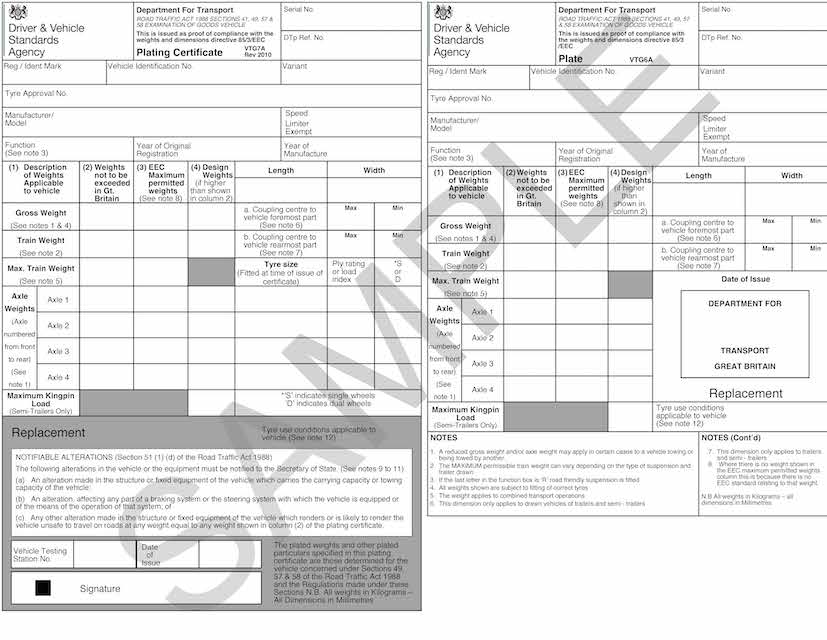HGV and trailer ministry plates and plating certificates
Updated 11 December 2024
Applies to England, Scotland and Wales
1. Overview
Heavy goods vehicle (HGV) and trailer plates (sometimes called ‘ministry plates’) and plating certificates are paper documents that show important information about the vehicle or trailer.
Which vehicles and trailers need plates and plating certificates
HGVs and trailers must have plates and plating certificates if they require an annual MOT.
This includes:
- goods vehicles with a gross weight of more than 3,500 kilograms (kg)
- vehicles that are built or have been adapted to form part of an articulated vehicle
- semi-trailers
- horseboxes with a gross weight of more than 3,500kg
- ‘A’ frame trailers and converter dollies manufactured on or after 1 January 1979
- trailers with an unladen weight of more than 1,020kg with powered braking systems (instead of standard overrun brakes and as well as the required parking brake)
Check form V112G for a list of goods vehicles that are exempt.
What you have to do with plates and plating certificates
| Document name | Document reference | What to do with the document |
|---|---|---|
| HGV plate | VTG 6A | Display in the vehicle’s cab - it must be securely fixed, be clear enough to read, and in a position that’s easy to see and read it from. |
| HGV plating certificate | VTG 7A | Keep it with the vehicle’s paperwork in the office or with the vehicle. |
| Trailer plate | VTG 6T | Display on the trailer’s chassis - it must be securely fixed, be clear enough to read, and in a position that’s easy to see and read it from. |
| Trailer plating certificate | VTG 7T | Keep it with the vehicle’s paperwork in the office or with the vehicle. |
Information on the plate and plating certificate
The plate shows these details about the vehicle or trailer:
- the serial number
- the DTp reference number - this is a Department for Transport (DfT) number related to the braking information
- the registration (number plate)
- the vehicle identification number (VIN)
- the manufacturer and model
- whether or not it’s exempt from needing a speed limiter
- the function (rigid or articulated)
- the date of original registration
- the year of manufacture
- the gross weight, train weight and maximum train weight
- the length and width
- the axle weights
- conditions about the use of tyres
The plating certificate shows the same information, and also shows the tyre size and ply rating or load index.

An example of a plating certificate (left) and a 'ministry' plate (right).
2. Get the plate and plating certificate for a new vehicle or trailer
The way you get the plate and plating certificate depends on whether it’s an HGV or trailer.
HGV
-
Register the vehicle with DVLA if this has not already been done.
-
Record the HGV’s details with the Driver and Vehicle Standards Agency (DVSA).
DVSA will send you the plate and plating certificates when you’ve recorded the details with them.
There’s no fee for this.
Trailer
The trailer manufacturer must apply for the plate and plating certificate before they sell the trailer. They will give you the documents.
If you’re a trailer manufacturer, you do this by applying to DVSA for permission to supply a large goods trailer for use on the road.
There’s no fee for this.
3. Change the details on the plate and plating certificate
You need to get an updated plate and plating certificate if you make a ‘notifiable alteration’. These include changes to:
- the chassis
- the tyres
- the brakes
- the weight you can carry
Changing the weight you can carry is known as:
- ‘up-plating’ if you want to increase the maximum permitted weight you can carry and have not made physical changes to the design
- ‘uprating’ if you want to increase the maximum permitted weight you can carry and the design has been modified
- ‘down-plating’ if you want to reduce the maximum permitted weight you can carry and have not made physical changes to the design (this can lower its vehicle tax rate)
- ‘downrating’ if you want to reduce the maximum permitted weight you can carry and the design has been modified (this can lower its vehicle tax rate)
It costs £27.
4. Fix mistakes on your plate or plating certificate
You can apply to get information corrected on your ministry plate or plating certificate if you think it’s wrong.
You need to attach evidence that it’s wrong when you apply. Depending on how the vehicle was approved, you will need send a photocopy of either the:
- certificate of conformity
- IVA certificate
Fill in the change a heavy goods vehicle (HGV) plated details or notify alterations form to apply.
5. Replace a lost or damaged plate or plating certificates
You can get a copy of your plate or plating certificate to print yourself if you have lost or damaged the original. You can:
- download your HGV or trailer’s ministry plate or plating certificate online using the service to replace a lost or damaged MOT certificate - this service is free
- apply to get a replacement HGV or trailer plating certificate or ministry plate by email – it costs £13
Print the plate and plating certificate
You will get an A4 PDF document to print. You will need to print this out and display the plate:
- within the vehicle’s cab if it’s an HGV
- on the chassis if it’s a trailer
